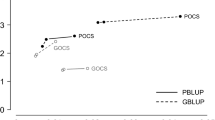Abstract
This study compares population-wide positive assortative mating (PAM) with open-nucleus breeding with an elite and main population when more effort is allocated to parents of the elite. A companion study showed that PAM is advantageous when testing effort is independent of parental value. In the present study, unbalanced testing was imposed by varying the number of crosses or the number of genotypes per cross. These unbalanced alternatives are compared with PAM, where the testing effort was varied so that better parents were mated more frequently. More effort allocated to parents of higher rank increased the additive effect and the additive variance and only slightly altered the group coancestry and inbreeding in the breeding population (BP) compared with completely balanced scenarios. Of particular interest to the breeder, large enhancement of the additive variance in the BP contributed to higher gains in the production population (PP). These simulations demonstrate that population-wide PAM leads to higher genetic gains compared with open-nucleus alternatives at any desired target level of diversity in the PP. This is true for both balanced (part I) and unbalanced distribution of testing effort (part II).







Similar content being viewed by others
References
Bourdon RM (1997) Understanding animal breeding. Prentice Hall, Upper Saddle River
Burdon RD, Namkoong G (1983) Short note: multiple populations and sublines. Silvae Genet 32:221–222
Cotterill PP (1989) The nucleus breeding system. Proc South For Tree Improv Conf 20:36–42
Cotterill PP, Dean CA, Cameron J, Brindbergs M (1989) Nucleus breeding: a new strategy for rapid improvement under clonal forestry. In: Gibson GL, Griffin AR, Matheson AC (eds) Breeding tropical trees: population structure and genetic improvement strategies in clonal and seedling forestry. (Proceedings of a conference held in Pattaya, Thailand, 28 November–3 December 1988) Winrock International, Arlington, pp 39–51
Danell Ö (1995) Breeding programs in Sweden. 1. General approach. SkogForsk. Arbetsrapport nr 302, pp 1–4
del-Bosque González AS (1989) Simulations of nucleus breeding schemes for wool production. PhD Dissertation, University of New England, Armidale
Hagedorn SF (1991) Breeding Pinus patula for plantation establishment in the Natal midlands. (Annual research report 1991) Institute for Commercial Forestry Research, Pietermaritzburg, pp 204–207
Jorjani H (1995) Genetic studies of assortative mating in selected and unselected populations. PhD thesis, Swedish University of Agricultural Sciences, Uppsala
Li B, McKeand S, Weir R (2000) Impact of forest genetics on sustainable forestry—results from two cycles of loblolly pine breeding in the US. J Sustain For 10:79–85
Lindgren D, Mullin TJ (1997) Balancing gain and relatedness in selection. Silvae Genet 46:124–129
Lstibůrek M, Mullin TJ, Lindgren D, Rosvall O (2004) Open-nucleus breeding strategies compared with population-wide positive assortative mating I. Equal distribution of testing effort. Theor Appl Genet. DOI 10.1007/s00122-004-1746-1
McKeand E, Beineke F (1980) Sublining for half-sib breeding populations of forest trees. Silvae Genet 29:14–17
McKeand SE, Bridgwater FE (1998) A strategy for the third breeding cycle of loblolly pine in the southeastern US. Silvae Genet 47:223–234
Mikola J (2002) Long-term tree breeding strategy in Finland: integration of seed production and breeding. In: Haapanen M, Mikola J (eds) Integrating tree breeding and forestry. (Proceedings of the Nordic group for management of genetic resources of trees, Mekrijärvi, March 2001. Research papers 842) Finnish Forest Research Institute, Mekrijärvi, pp 12–13
Mullin TJ, Park YS (1995) Stochastic simulation of population management strategies for tree breeding: a new decision-support tool for personal computers. Silvae Genet 44:132–141
Namkoong G, Kang HC, Brouard JS (1988) Tree breeding: principles and strategies. Monographs on theoretical and applied genetics. Springer, Berlin Heidelberg New York
Roden JA (1994) Review of the theory of open nucleus breeding systems. Anim Breed Abstr 62:151–157
Rosvall O, Mullin TJ (2003) Positive assortative mating with selection restrictions on group coancestry enhances gain while conserving genetic diversity in long-term forest tree breeding. Theor Appl Genet 107:629–642
Rosvall O, Lindgren D, Mullin TJ (1999) Sustainability robustness and efficiency of a multi-generation breeding strategy based on within-family clonal selection. Silvae Genet 47:307–321
Rosvall O, Mullin TJ, Lindgren D (2003) Controlling parent contributions during positive assortative mating and selection increases gain in long-term forest tree breeding. For Genet 10:35–53
Ruotsalainen S, Lindgren D (2000) Stratified sublining: a new option for structuring breeding populations. Can J For Res 30:596–604
Ruotsalainen S, Lindgren D (2001) Number of founders for a breeding population using variable parental contribution. For Genet 8:57–67
Smith C (1988) Genetic improvement of livestock, using nucleus breeding units. World Anim Rev 65:2–10
Wei RP, Lindgren D (1995) Optimal family contributions and a linear approximation. Theor Popul Biol 48:318–332
White TL (1992) Advanced-generation breeding populations: size and structure. In: Resolving tropical forest resource concerns through tree improvement, gene conservation and domestication of new species. (Proc IUFRO Conf Breeding Tropical Trees held in Cartagena and Cali, Colombia, 9–18 October 1992), pp 208–222
White TL, Hodge GR, Powell GL (1993) An advanced-generation tree improvement plan for slash pine in the southeastern United States. Silvae Genet 42:359–371
White TL, Matheson AC, Cotterill PP, Johnson GR, Rout AF, Boomsma DB (1999) A nucleus breeding plan for radiata pine in Australia. Silvae Genet 48:122–133
Willis MB (1998) Dalton’s introduction to practical animal breeding. Blackwell, Malden
Acknowledgements
We gratefully acknowledge financial support from the Föreningen Skogsträdsförädling (Swedish Tree Breeding Association) and the North Carolina State University–Industry Cooperative Tree Improvement Program. We also thank Dr. Jennifer Myszewski and Dr. Floyd Bridgwater for their valuable comments on the manuscript and Dr. Ross Shepherd for his generous help with the animal breeding terminology.
Author information
Authors and Affiliations
Corresponding author
Additional information
Communicated by D.B. Neale
Rights and permissions
About this article
Cite this article
Lstibůrek, M., Mullin, T.J., Lindgren, D. et al. Open-nucleus breeding strategies compared with population-wide positive assortative mating . Theor Appl Genet 109, 1169–1177 (2004). https://doi.org/10.1007/s00122-004-1737-2
Received:
Accepted:
Published:
Issue Date:
DOI: https://doi.org/10.1007/s00122-004-1737-2




